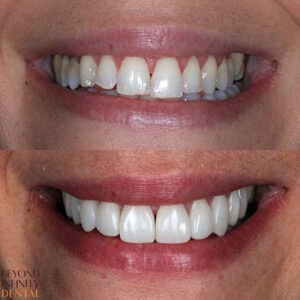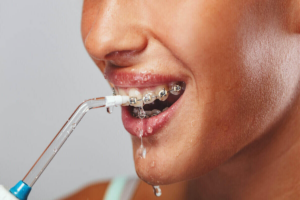Are you weighing up your options and trying to decide between teeth bonding vs veneers?
These days, dentistry is as much about the appearance of your smile as it is about oral health. We’re all far more aware of how much our smile can affect us – not just aesthetically but in how others interact with us and our overall self-confidence.
Dentists have a range of cosmetic options to help us replace missing teeth with crowns and dental implants. Additionally, discoloured, chipped, cracked, and misshapen teeth can be transformed with dental bonding and dental veneers. So which should you choose?
Teeth Bonding vs Veneers: How to Choose?
Both bonding and veneers are cosmetic treatments that can enhance the attractiveness of your teeth and the beauty of your smile. The treatments improve common aesthetic concerns, such as chips, gaps, cracks and discolouration. However, each treatment has pros and cons that may determine your preference for one procedure over the other. Let’s take a look.
What is dental bonding?
The dental bonding procedure involves applying a resin composite material to the surface of the tooth. This can be moulded by the dentist to fill fine cracks, close small gaps, or applied in a thin layer to cover the entire tooth.
 When composite is used to cover the whole tooth, the procedure is often referred to as composite veneers.
When composite is used to cover the whole tooth, the procedure is often referred to as composite veneers.
Once the resin has been applied to the tooth, it’s hardened with a high-intensity light that adheres the resin securely to the tooth.
Teeth bonding is a quick procedure that can be completed in just one session. It doesn’t even require anaesthesia unless you also need to have your tooth filled, your tooth needs a lot of work or if you have damaged the tooth near a nerve.
An appropriately coloured resin that closely matches the colour of your tooth is chosen before the procedure begins.
What are dental veneers?
A dental veneer can be made from porcelain or composite and is a thin, hard-wearing shell affixed to the front of a tooth. All-ceramic dental veneers can be applied to just one tooth to correct an imperfection or applied to a row of teeth to create a perfectly straight, white smile.
The procedure typically requires several visits to complete. Your tooth or teeth are prepared to receive the veneers by removing a sliver of enamel from the front surface. Impressions of your teeth are taken and sent to a laboratory where your shells are custom-made. When the veneers are returned to us, we affix them to the teeth using a light-activated adhesive that bonds them firmly in place.
Teeth Bonding vs Veneers – What’s the difference?
Both procedures require that your mouth is healthy with no signs of active gum disease or tooth decay. These can compromise the effectiveness of the treatments and lead to further oral health issues that may necessitate additional procedures. For example, untreated tooth decay can advance to the tooth’s centre, where the nerve is situated. An infection here may cause painful toothache and necessitate a root canal procedure to prevent the infection from spreading.
- Appearance
Veneers and bonding are designed to match the colour of your surrounding teeth. However, porcelain veneers are stain-resistant and retain the same colour throughout their life, whereas bonding resin may discolour over time.
- Treatable concerns
Either procedure can be the right choice, depending on your circumstances.
Your dentist can shape composite resin-like clay to fit your tooth. It is particularly useful for minor chips and cracks, whereas porcelain veneers are ideal for addressing more pronounced issues.
- Timeframe
Dental bonding can be completed in one session compared to porcelain veneers that can take two or three sessions over a period of weeks. 
- Tooth preparation
Bonding requires minimal preparation of the teeth, whereas dental veneers do require a little more preparation. This involves removing a thin sliver of enamel from the front of the tooth to ensure the veneer does not protrude away from the natural line of the teeth.
- Is the procedure reversible?
Dental bonding is a reversible procedure, but dental veneers are permanent and cannot be reversed.
- Longevity
Composite resin is not as hard-wearing as natural teeth or porcelain. However, by following a good oral hygiene regime and visiting the dentist regularly for check-ups, you can ensure your procedure lasts as long as expected. Composite bonding can last for an average of 5-7 years, but porcelain dental veneers typically last for 10-15 years.
- Cost
The cost of dental bonding is considerably less than dental veneers, but it is more prone to chipping and other damage, as well as discolouration. You may have to replace the bonding much more frequently than you would need to replace all-ceramic veneers.
The conclusion
Overall, in the teeth bonding vs veneers debate, the winner varies and is very much dependent on your individual circumstances. While veneers need to be custom-made, dental bonding is an affordable and fast procedure. So, if you are looking for a quick fix, bonding is a suitable treatment for you, particularly if you require minor cosmetic enhancements to your smile.
However, if you’re looking for a long-lasting solution, dental veneers are a great investment. Both procedures are designed to correct flaws in your smile, so that you can feel more confident in your appearance. Why not schedule an appointment with Beyond Infinity Dental or call us on (02) 8806 3799. today to find out which treatment is more appropriate for you.
References
Teeth Bonding
https://www.webmd.com/oral-health/guide/dental-bonding#:~:text=Teeth%20bonding%20is%20a%20procedure,or%20improve%20a%20person’s%20smile.
Dental Veneers
https://www.webmd.com/oral-health/guide/veneers









